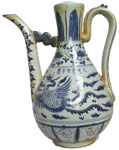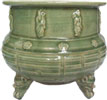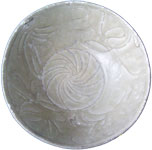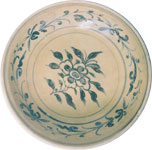|
Categories
of
Chinese
Ceramic Art
The
most important types of Chinese Porcelain and Stoneware Ceramics are explained below. See many examples of each
style by going to the Ceramics
Directory of The Chalre Collection of Asian Ceramic
Art.
 Blue
and White Blue
and White
Porcelain
(Main
Period: 1400 to 1700 AD)
 Underglaze Blue Porcelain is the best known type of ceramics. It is often referred to as
'Blue and White' from its blue cobalt oxide painted below the
glaze. The reason Chinese
Porcelain became so famous is probably because it was traded widely by Europeans from the 17th century onward. By that time, China had already
been exporting Blue and White Porcelain to the Middle East and Southeast Asia for centuries. Underglaze Blue Porcelain is the best known type of ceramics. It is often referred to as
'Blue and White' from its blue cobalt oxide painted below the
glaze. The reason Chinese
Porcelain became so famous is probably because it was traded widely by Europeans from the 17th century onward. By that time, China had already
been exporting Blue and White Porcelain to the Middle East and Southeast Asia for centuries.
The first Portuguese merchants to visit China eventually realized the value of the "white gold" and started importing limited quantities for the
nobles of Europe. It was in 1603 that the Dutch East India Company (VOC) sent a load of
Chinese Blue and White Porcelain to Amsterdam where it was sold for
an enormous profit. From that date on, Chinese Blue and White Porcelain
became known as the finest in the world
 and much desired in Europe and
later in North America. and much desired in Europe and
later in North America.
Blue
and White Porcelain first appeared during the Yuan dynasty (1127 - 1279)
but became so pervasive during the Ming dynasty (1368 - 1644)
that today Blue and White and Ming are commonly used
interchangeably.
CLICK
HERE to
see examples of Blue
and White Porcelain from
The Chalre
Collection.
 White White
Porcelain

(Main
Period: 1000 to 1400 AD)
White
Porcelains began to be made
on a large scale at Jingdezhen and at many other southern kilns from the time of the Song
dynasty (960 - 1279). The most famous of the early Porcelains was
qingbai (pronounced ching-pie). Whiteware Ceramics were
traded throughout Southeast Asia. Until eclipsed by Blue
and White Porcelain in the 14th century, it was the dominant Chinese
Ceramic of its era.
 Qingbai
(also called yingqing) translates literally as "clear
bluish-white." The jade-like texture of the Porcelain
results from the clear glaze that contains iron in small
amounts. When applied over a white Porcelain body the glaze produces a greenish-blue colour. Some have incised or
molded decorations. Qingbai
(also called yingqing) translates literally as "clear
bluish-white." The jade-like texture of the Porcelain
results from the clear glaze that contains iron in small
amounts. When applied over a white Porcelain body the glaze produces a greenish-blue colour. Some have incised or
molded decorations.
CLICK
HERE to
see examples of Whiteware
Ceramics from
The Chalre
Collection.
 Celadon Celadon
Ceramics
(Main
Period: 1000 to 1600 AD)
Celadon is a western word used originally to describe the green glaze of
Ceramics from Longquan in China. The glaze is made of clay mixed with wood ash and is 2-5% iron, and must be fired in an oxygen reduced atmosphere.
The Celadon method began to be used in the 7th century in China. By the time of the Song dynasty (960-1280), the skills of the potters had advanced to a high degree that fine vessels had a jade-like appearance and texture. By the 14th century, motifs such as lotus flowers and stylized chrysanthemums were incised for decoration.
 Celadon production in Thailand seems to have started in the later part of the 14th century - around the time of the 'Ming ban' of 1371 when emperor Hongwu decided to prohibit his subjects from trading with all other people. It is thought that Chinese migrants were
responsible for development of early Celadon production in
Thailand. Celadon production in Thailand seems to have started in the later part of the 14th century - around the time of the 'Ming ban' of 1371 when emperor Hongwu decided to prohibit his subjects from trading with all other people. It is thought that Chinese migrants were
responsible for development of early Celadon production in
Thailand.
CLICK
HERE to
see examples of Celadon
from
The Chalre
Collection.
 Qing
Dynasty Qing
Dynasty
Porcelain
(Main
Period: 1700 to 1900 AD)
During the Qing dynasty (1644 -
1911), potters began using bright colours to adorn plates and vases with meticulously painted scenes. Porcelain ceramicists began producing five-coloured ware
by applying a variety of underglaze pigments to floral, landscape and figurative scenes - a style which was (and is) highly sought-after in the West.
During the Yung Cheng era (1723-1735)
Porcelain was enhanced by the development of fencai enamel in a wide range of colours and
tones. enhanced by the development of fencai enamel in a wide range of colours and
tones.
CLICK
HERE to
see examples of Multi-Colour Porcelain
from
The Chalre
Collection.
 Underglaze Black Underglaze Black
Porcelain
(Main
Period: 1400 to 1700 AD)
Long before the Chinese made
Blue and White Porcelain using cobalt, a black iron oxide was used to paint motifs below a clear protecting glaze. This technique, used at Cizhou in northern China, developed independently from the
Celadon production in southern China.
By the 14th century, the so-called underglaze technique appeared in Thailand and Vietnam.
Fish and chrysanthemums, representing long life and happiness, were preferred at Thailand. In Vietnam, a flower motif was common.
It is highly possible that the underglaze decoration technique (painting with oxides and then applying glaze) arrived in both Thailand and Vietnam with
immigrating Chinese potters. possible that the underglaze decoration technique (painting with oxides and then applying glaze) arrived in both Thailand and Vietnam with
immigrating Chinese potters.
CLICK
HERE to
see examples of Underglaze Black
from
The Chalre
Collection.
 Tang
Dynasty Tang
Dynasty
Ceramics
(Main
Period: 700 to 900 AD)
Early
Chinese Coloured Stoneware is often called Sancai which means three-colours.
However, the colours of the glazes used to decorate the wares of the Tang dynasty
(618 - 911) were not limited to three in number. In the West, Tang
Sancai wares were sometimes referred to as egg-and-spinach by dealers for the use of green, yellow and white. Though the latter of the two colours might be more properly described as amber and off-white / cream.
Sancai wares originate from northern China. At kiln sites located at Tongchuan, Neiqui county in Hebei and Gongxian in Henan, the clays used for burial wares were similar to those used by Tang potters. The burial wares were fired at a lower temperature than
contemporary whiteware. county in Hebei and Gongxian in Henan, the clays used for burial wares were similar to those used by Tang potters. The burial wares were fired at a lower temperature than
contemporary whiteware.
Burial wares, such as the well-known representations of camels and horses, were cast in sections, in moulds with the parts luted together. In some cases, a degree of individuality was imparted to the assembled figurines by hand-carving.
CLICK
HERE to
see examples of Tang Pottery
from
The Chalre
Collection.
 Earthenware Earthenware
Pottery
(Main
Period: 1000 to 1600 AD)
 Earthenware is the earliest
type of pottery and is known to have existed for the past 10.000 years. Secondary clay was formed on the pottery wheel or rolled into strings and laid on top of another to form the pot. Earthenware was commonly fired in simple open pits and therefore found in most early civilizations. Firing temperatures normally reached 400C to 700C. Earthenware is the earliest
type of pottery and is known to have existed for the past 10.000 years. Secondary clay was formed on the pottery wheel or rolled into strings and laid on top of another to form the pot. Earthenware was commonly fired in simple open pits and therefore found in most early civilizations. Firing temperatures normally reached 400C to 700C.
It is thought that most of the Earthenware found its way on trade ships as necessities of the men sailing the ships. Their limited number suggests that
Earthenware was never made for export.
CLICK
HERE to
see examples of Earthenware
from
The Chalre
Collection.

Go to the
Chalre
Collection
of
Asian Ceramic Art

|